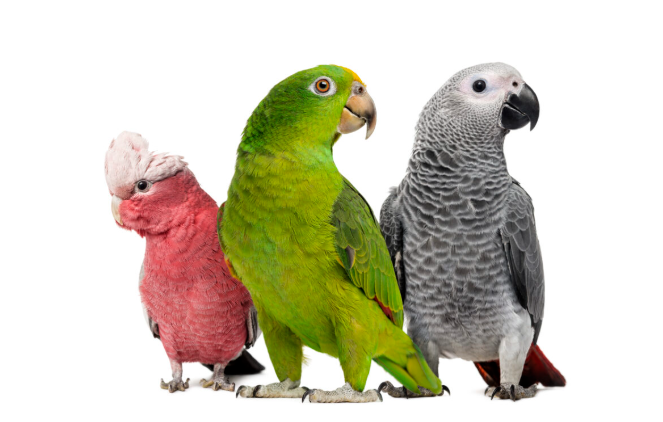Tips for Trust-Building and Socialization
Parrots are intelligent, social birds that thrive on companionship. However, building trust with a parrot—especially a new or shy one—takes time, patience, and the right approach. Whether you’ve just brought home a parrot or want to strengthen your existing bond, these tips will help you create a loving and trusting relationship with your feathered friend.
1. Give Your Parrot Time to Adjust
When bringing a new parrot home, allow them time to get used to their surroundings before handling them. Birds can be naturally cautious in new environments, so give them space to feel safe.
What You Can Do:
✅ Place the cage in a quiet, comfortable spot where they can observe the household.
✅ Avoid sudden movements or loud noises.
✅ Let them get used to your presence by sitting nearby and talking softly.
2. Talk to Your Parrot Every Day
Parrots are highly social creatures that respond well to human voices. Talking to your parrot in a calm, friendly tone helps them associate you with safety and companionship.
What You Can Do:
✅ Greet your parrot in the morning and before bedtime.
✅ Use a gentle, positive tone when speaking.
✅ Narrate your daily activities, like “I’m making coffee” or “Let’s clean your cage.”
Even if your parrot doesn’t talk back, they are always listening and learning!
3. Offer Treats by Hand
Food is a great way to earn your parrot’s trust. Offering their favorite treats directly from your hand helps them associate you with positive experiences.
What You Can Do:
✅ Start by placing a treat in your palm and holding it near their cage.
✅ Gradually encourage them to take the treat from your fingers.
✅ Use special treats they love, such as small pieces of fruit, nuts, or millet spray.
Once your parrot willingly takes food from your hand, you’re on your way to building trust!
4. Respect Their Boundaries
Just like people, parrots have different personalities and comfort levels. Some birds bond quickly, while others take time. Pay attention to your parrot’s body language and respect their signals.
Signs of Comfort:
✔️ Fluffing feathers
✔️ Relaxed posture
✔️ Preening or blinking slowly around you
Signs of Fear or Discomfort:
❌ Flattened feathers
❌ Backing away or turning their head
❌ Hissing or lunging
If your parrot seems nervous, take a step back and give them more time before trying again.
5. Train with Positive Reinforcement
Teaching your parrot simple commands, like stepping onto your hand, can strengthen your bond. Use positive reinforcement to make learning fun and rewarding.
Step-Up Training:
1️⃣ Hold your hand or a perch in front of your parrot.
2️⃣ Say “Step up” in a gentle, encouraging tone.
3️⃣ If they step up, reward them with a treat and praise.
4️⃣ If they hesitate, try again later—never force them.
Over time, training sessions will help your parrot associate you with trust and fun.
6. Spend Quality Time Together
Parrots are flock animals, meaning they naturally want to be part of a social group. Spending time together outside the cage is essential for building a strong bond.
Ideas for Quality Time:
✅ Let your parrot sit on your shoulder while you relax.
✅ Gently scratch their head if they enjoy it.
✅ Play games, like peek-a-boo or fetch with small toys.
✅ Allow supervised out-of-cage time for exercise and exploration.
The more time you invest in your parrot, the closer your bond will become.
7. Provide Enrichment and Stimulation
A happy parrot is a well-bonded parrot! Keeping your bird mentally and physically engaged helps build trust and prevents boredom.
Ways to Keep Your Parrot Engaged:
✅ Toys – Rotate different toys, such as chewable wood, bells, and puzzle toys.
✅ Music & Talking – Play calming music or talk to them regularly.
✅ Foraging Activities – Hide treats in foraging toys to encourage natural behaviors.
Parrots that feel entertained and secure are more likely to form a close bong with their owner.
Building a strong bond with your parrot doesn’t happen overnight. Some birds take days to warm up, while others may take weeks or even months. The key is patience and consistency.
What You Can Do:
✅ Interact with your parrot daily, even if it’s just sitting near them and talking.
✅ Stick to a routine—parrots feel secure when they know what to expect.
✅ Never force interactions; let your parrot come to you on their terms.
The more consistent you are, the more your parrot will learn to trust and depend on you as a companion.
9. Avoid Negative Experiences
Parrots have excellent memories, and negative experiences can set back your bonding progress. To ensure your parrot associates you with safety and positivity, avoid:
❌ Forcing them to step up if they’re scared.
❌ Chasing them or grabbing them suddenly.
❌ Yelling or using punishment—this can cause fear and distrust.
Instead, always approach them gently, use positive reinforcement, and respect their comfort levels.
10. Learn Your Parrot’s Unique Personality
Every parrot is different—some are naturally cuddly, while others prefer to interact from a distance. Pay attention to what your bird enjoys and adjust your bonding approach accordingly.
Signs Your Parrot is Bonding with You:
✔️ They approach you willingly.
✔️ They mimic your sounds or words.
✔️ They preen themselves or you (a sign of trust).
✔️ They play and interact with you.
Once your parrot starts seeking out your attention and showing affection, you’ll know your bond is strong!
Final Thoughts
Bonding with your parrot is a rewarding experience that takes time, patience, and understanding. By consistently offering positive interactions, respecting their comfort levels, and engaging in fun activities together, you’ll build a deep and lasting relationship with your feathered friend.
Do you have a special bonding moment with your parrot? Share your experience in the comments below! 🦜❤️



